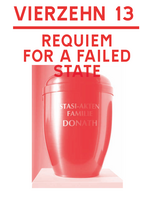
REQUIEM FOR A FAILED STATE
April 14 to August 5, 2018
September 22 to Oktober 14, 2018 (Auf AEG, Nuremberg)
Artists: Nadja Buttendorf & Anne Baumann, Ariamna Contino & Alex Hernández, Susan Donath, Darsha Hewitt in Zusammenarbeit mit Sophia Gräfe, Tamami Iinuma, Sven Johne, KLOZIN (Wilhelm Klotzek & David Polzin), Henrike Naumann, Carsten Saeger, Malte Wandel, Katrin Winkler
Artist in Residence: Henry Bradley
Students of the seminar »Under the Ice« by Anna Voswinckel and Carsten Möller of the Academy of Fine Arts Leipzig: Jane Beran, Katrin Esser, Eric Meier, Stefania T. Smolkina, Sarah Veith, Brenda M. Wald
In 1989/90, the German Democratic Republic imploded once and for all. The impossible to reform »dictatorship of the working class« was in ruins. Citizens reclaimed the power of the people for themselves. The state apparatus was dissolved, the two German states were united, and the traditional »state-run enterprises« were liquidated as bankruptcy assets to primarily West German investors. Long-sought-after freedom, the hope for a better life and for a non-aligned, peaceful world was in sight–and became a reality for many. But deindustrialisation also followed at a previously unseen pace and with it a major economic crisis. Massive unemployment, depopulation, high vacancy rates and neglect and dilapidation resulted. In hindsight, the 1990s appear as an anarchic »wild East« characterised by cultural escapism, economic adventurism and escalating xenophobia. The new freedom compelled every East German person to reorient themselves; it meant risks and caused personal, biographic and psychological crises. Having become »metaphysically homeless«, not a few yearned for redemptive images of the self and the world.
The judicial, journalistic and scholarly processing of this recent history began with little temporal distance. With each anniversary, the number of reference books and memoirs, mass-market educational programmes, films, novels and TV documentaries multiplied. Through various contextualizations, repetitions and re-enactments, a mediated patina lies over the limited material of historical records, sometimes veiling the view of gaps and rifts. Who is speaking off-screen and explaining the history of the images to us? Between the view of the GDR as a dictatorship and kitschy nostalgia for the East, nuances are often lacking in the popular discourse. To those affected, this professionalised coming to terms with the past often appears as an interpretive expropriation of one's biography. A chasm remains in the coming to terms.
Between the generation who functioned within the GDR system and their children, a remarkable– polemically spoken with reference to Hermann Lübbe–»communicative silence« rules. Vociferous debate between these generations–comparable to that in West Germany in the late 1960s–about individual, culpable entanglements with the system and their aftereffects today have been missing, until now. The path of Uwe Mundlos, Uwe Böhnhardt and Beate Zschäpe–who came of age during the political changes–to the so-called »National Socialist underground« as well as the »evening strolls« of Pegida (the ugly cousin of the Monday Demonstrations) are reason enough to question the present day repercussions of German experiences of dictatorship, the permanent paternalism, closed world views, militarism and rigid identities. Against this backdrop, the abandoned plazas in Berlin and Leipzig for »Monuments to Freedom and Unity« for the 25th anniversary of the German re-unification appear perfectly symptomatic of an unresolved past. Despite political will, it was not possible to bring contemporary monument design and social acceptance into agreement.
The exhibition project »Requiem for a Failed State« focuses on the perspective of a young generation of artists. How do those born after 1980 look back on the end of the GDR, the results of the political changes and the decade of disorientation in the 1990s of which they have few or no individual memories? How long does a vanished state linger? Who says what about the past, and who doesn't? What questions do those born in the former East and West ask? Which facets of these historical events interest young artists from around the world? What connections do they draw to our present, and what do they discover?
In Cooperation with the seminar »Under the Ice« by Anna Voswinckel and Carsten Möller of the Academy of Fine Arts Leipzig.
Funded by:



